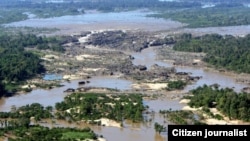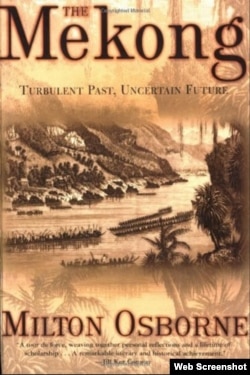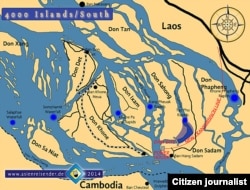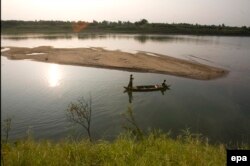[Editor’s note: Milton Osborne is one of the foremost historians of the Mekong River. His 2000 book, “The Mekong: Turbulent Past, Uncertain Future,” was the result of about 40 years spent traveling up and down the river’s length. The author has researched and written about the history of the river, its governance and the contemporary political and economic challenges of the countries by which it flows. Now 80 years old, Osborne spoke to VOA Khmer’s Soksreinith Ten from his home in New South Wales, Australia, to explain why he believes that dam projects are a serious threat to the Mekong and the people who depend on it. This interview has been edited for length and clarity.]
When did you first become interested in the Mekong River?
I first became interested in the Mekong river when I was posted to the Australian Embassy in Phnom Penh in 1959. That was the first time I saw the river, and I realized, of course, that it was a very important river in terms of the countries through which it flowed. In Cambodia, for instance, 80 percent of the population’s annual protein intake comes from fish taken out of the river. Over the years after 1959, when I kept on going back to the countries through which the river flows, I realized there was a tremendous story to be told about how the river worked and the exploration of the river, which took place in the 1860s. It was one of the greatest expeditions of the 19th century.
Then, later, after I became very interested in plans to build dams on the river, I began to realize that there were problems associated with building dams that I as a person who did not have technical training had to learn about. And then, in the 1980s and the 1990s, I found the Chinese were for the very first time building dams on the river. Of course, they have now built or are in the process of completing the building of seven dams on the Mekong River where it flows through China.
Were the Chinese plans to build dams the first serious threats to the river?
There were plans to build dams on the river after it flows out of China, but for a whole variety of reasons, those plans never came to fruition. But, indeed, the Chinese dams, when they started building them—beginning in the 1980s and still building them now—certainly are going to have, and already have had, an effect on the way in which the river functions.
I think one of the things that people don’t think about or are not aware of is the fact that a river is an organic whole. You can’t just affect one small section or even one big section of the river, and think that it will not have an effect elsewhere. So, by building dams on the river in China, that affects the amount of water that flows down the river into Laos and Cambodia, and into Vietnam, and that is a very important fact.
In your book, you wrote that the different riparian states face different problems and threats regarding the river. Could you explain that?
If you take an actual case of how the river works and think about the relationship between China and, for instance, Laos, the Chinese government says that the water flowing into the Mekong River from the tributaries in China only contributes something in the order of 10 or 11 percent of the total water that flows down the river. But, during the dry season, during the months we’ve just had from late November into May, the amount of water that flows down the Mekong River from China, as far as the Lao capital at Vientiane is something like 40 percent of the water in the river. So you can’t just isolate one period of time or one section of the river and not recognize that the effect of building dams has an effect much further down the river from where the actual dam has been built.
"Now the scientists believe something like 80 or 90 percent of the sediment that flows down the river into the Mekong Delta has in the past come from China. But we do know that already the dams that have been built in China are restricting the amount of sediment that is flowing down the river."
We will have to see over the years what actually happens, but the modeling that has been done already suggests that the dams that have been built in China are already affecting and are going to affect in the future the amount of water that flows into the Tonle Sap Lake in Cambodia. It might affect that amount of water by as much as 10 percent each year, and that could have a very substantial effect on the fish that grow to maturity in the Tonle Sap. Certainly, in the last couple of years, the amount of water that flows into the Tonle Sap has been a smaller amount than has previously been the case.
What are the potential consequences for people’s ways of life due to the dams?
The changes that result from building dams have a whole range of effects. One of the effects that is not talked about as much as it should be is the fact that dams prevent sediment flowing down the river. I am sure you have seen the river at times in Cambodia where it is flowing, particularly during the end of the wet season, [there’s a large] amount of sediment that flows down the river.
This is of great importance both for agriculture along the banks of the river, and of a great importance, particularly, for the agricultural production of the Mekong Delta. Now the scientists believe something like 80 or 90 percent of the sediment that flows down the river into the Mekong Delta has in the past come from China. But we do know that already the dams that have been built in China are restricting the amount of sediment that is flowing down the river. The sediment carries with it nutrients of great importance for the crops that grow along the banks of the Mekong and in the Mekong Delta, particularly in Vietnam. So, if you block the sediment flowing because the dams have been built, this is going to ultimately have a very negative effect.
In terms of the governance of the river, to what extent are countries acting in their individual interests?
The expectation in 1995 when the Mekong River Agreement was signed by the four countries—Laos, Cambodia, Thailand and Vietnam—was that there would be cooperation between the four member countries of the Mekong River Commission. My judgement is that at that stage it was certainly not thought that any of the individual countries would act in a way that was detrimental to the other members of the commission, the other countries through which the Mekong River flows.
That judgement has been proven to be wrong because it’s quite clear now that the countries of the Mekong River Commission face the prospect, or already have the prospect, of one country, Laos, being quite prepared to build dams on the river whether or not the other countries, particularly Cambodia and Vietnam, are opposed to the construction of dams on the river. The Lao government has already begun building, and is probably expecting it will have completed the dam at Xayaburi. The other dam that is also a matter of great controversy is the prospect of the dam being built at Don Sahong.
Now, there is no way that the Mekong River Commission can stop the government of Laos acting in this way. The powers of the Mekong River Commission do not include the opportunity or the capacity to tell any country to act in a particular way.
Are there any mechanisms to resolve these tensions over the governance of the river?
I don’t have any expectation that this issue will be solved, I am very sorry to say. I think that the interests of the individual countries—and in this case, the interests of Laos—have simply triumphed over the idea that it would be possible to prevent any individual country acting in a way that was detrimental to the interests of the people bordering the river as a whole.
The Lao government sees the opportunity of earning foreign exchange by selling electricity from the dam it is already building and the probable dam it will be building at Don Sahong. And, despite the protests from Cambodia and Vietnam, it appears that the Lao government is simply going to pursue its own interests, rather than pursue the interests of the region as a whole.
"I turned 80 years of age this year, and the changes that have taken place in the Mekong already—the dams that have been built, the changes that are taking place on its flow—all of these changes have taken place in less than 40 years."
This comes back to the issue of the river as an organic whole. Sixty-plus million people depend on the Mekong for their subsistence in one way or another—that’s the countries of the Mekong River Commission, the four countries bordering the river after it flows out of China. What the Lao government has chosen to do is to ignore the interests of the other people who live along the river and to pursue its own goals.
Do you think climate change will have any effect on the flow of the river?
There has been a range of modeling done to try to estimate what the effects of climate change will be. There is considerable controversy over the extent to which glaciers have been reduced in the Tibetan plateau where the sources of the Mekong are found. Some very wild exaggerated estimations were made of just how much the glaciers have been reduced as the result of climate change.
But if climate change continues, there seems to be little doubt that the glaciers that currently provide snow melt during the northern summer will reduce the amount of water flowing into the Mekong. But there is other climate change modeling that suggests that there could be even more rain flowing or cascading into the Mekong in the lower parts of the river. I think the whole issue of climate change is a very real one—I am not in any sense denying that—but at the moment exactly how much change will come as the result of climate change I think is still awaiting to be fully analyzed.
"It is absolutely essential, in my judgment, for the future of the people who live along the river that a recognition is given to the fact that you cannot change the river by building dams without having negative effects."
You spent more than three decades traveling and researching the Mekong. How special is the river to you?
The Mekong has been a very considerable part of my life. I’ve managed to travel on large sections of the river, and it will always be an important memory for me. I think one of the most striking things for me is to realize that the changes that have taken place to the Mekong have taken place in less than half my own lifetime. I turned 80 years of age this year, and the changes that have taken place in the Mekong already—the dams that have been built, the changes that are taking place on its flow—all of these changes have taken place in less than 40 years. So a great river that is very important to me in terms of my own experience has been changed dramatically in the space of less than 40 years.
In your book, you predicted an “uncertain future” for the river. How has that prediction played out?
I certainly didn’t expect when that book was published 16 years ago that dams would being built in Laos. I thought that it was probable that the four countries of the Mekong River Commission would recognize that their interests would be served by not having any dams once the river flows out of China, when it flows to their countries, and that assumption was not correct. When I wrote the book and published it in 2000, 16 years ago, I did not expect that the Chinese would continue building dams at the rate that they have now done. So, the uncertain future has proved to be exactly that: very uncertain indeed.
Today, how do you foresee the river’s future?
It is a great river that has been changed irrevocably. It can never put back to where it was now that the dams have been built in China and are being built in Laos. It is absolutely essential, in my judgment, for the future of the people who live along the river that a recognition is given to the fact that you cannot change the river by building dams without having negative effects. And it is of vital importance that the reality of those negative effects should be realized by the countries through which the river flows.













